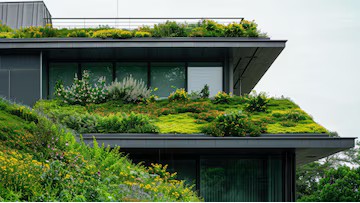
The urban landscape is evolving upward, and innovative roofing contractors are leading this vertical revolution with sustainable solutions that go far beyond traditional shingles and tiles. As cities grapple with challenges of climate change, pollution, and limited green space, green roofing—sometimes called living roofs—has emerged as a transformative approach to urban architecture. These vegetated roof systems, when installed by an experienced roofing contractor, offer impressive environmental, economic, and social benefits that are quite literally changing the face of our cities from gray to green.
The environmental benefits of green roofing systems are substantial and multifaceted. Living roofs act as natural air filters, with plants capturing airborne pollutants and releasing oxygen. A single 1,000-square-foot green roof can remove approximately 40 pounds of particulate matter from the air annually, significantly improving local air quality.
These roofing systems also play a crucial role in managing stormwater runoff—a major challenge in urban areas with extensive impervious surfaces. Green roofs can retain 70-90% of summer precipitation and 25-40% of winter precipitation, reducing strain on aging stormwater infrastructure and decreasing flood risks during heavy rainfall events.
Perhaps most significantly, living roofs help mitigate the urban heat island effect, where cities experience substantially higher temperatures than surrounding rural areas due to heat-absorbing materials like concrete and asphalt. By replacing heat-absorbing surfaces with vegetation, green roofs can reduce local temperatures by 3-5°C, creating more comfortable urban environments and reducing cooling costs.
While the upfront installation costs of a green roof typically exceed those of conventional roofing, the long-term economic benefits are compelling. Living roofs protect the underlying waterproofing membrane from UV damage and extreme temperature fluctuations, potentially doubling or tripling the roof's lifespan. This durability translates to significant savings in replacement and maintenance costs over time.
Buildings with green roofs also enjoy substantial energy savings. The insulating properties of soil and vegetation reduce heat transfer, decreasing cooling needs in summer by up to 75% and heating requirements in winter by up to 25%. These energy efficiencies translate to lower utility bills and reduced carbon footprints.
The transformation of barren rooftops into vibrant green spaces creates new opportunities for community engagement and improved quality of life. Accessible green roofs can serve as recreational spaces, community gardens, or outdoor classrooms, providing much-needed contact with nature in dense urban environments.
Studies have demonstrated that access to green spaces improves mental health, reduces stress, and enhances overall wellbeing. In healthcare settings, views of green roofs have even been linked to faster patient recovery times.
The transformation of our urban skylines from concrete and asphalt to living, breathing ecosystems represents not just an architectural trend, but a fundamental shift toward cities that work with nature rather than against it. As this movement grows, the once-humble roof is being recognized for what it truly is: a valuable opportunity to create healthier, more sustainable urban environments.
Contact a roofing professional at 68-38 Main Street #2 Flushing, NY 11367 (718)489-4009 https://www.kingsqueensroofing.com